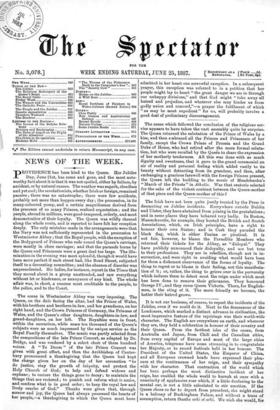The scene in Westminster Abbey was very imposing. The Queen,
on the dais facing the altar, had the Prince of Wales, with his brothers and brothers-in-law, and her grandsons, on her right hand, and the Crown Princess of Germany, the Princess of Wales, and the Queen's other daughters, daughters-in-law, and grand-daughters, on her left. The Royalties were in front, within the sacrarium, while some ten thousand of the Queen's subjects were as much impressed by the unique service as the Royal Family themselves. The music was partly selected from the compositions of the late Prince Consort, as adapted by Dr. Bridge, and was rendered by a select choir of three hundred voices. A " Te Denm " of the late Prince Consort was given with great effect, and then the Archbishop of Canter- bury pronounced a thanksgiving that the Queen had kept the charge given her on the day of her coronation "to do justice, stay the growth of iniquity, and protect the Holy Church of God; to help and defend widows and Orphans; to restore the things gone to decay; to maintain the things that are restored ; to punish and reform what is amiss, and confirm what is in good order; to keep the royal law and lively oracles of God." Thanks were given that, through sorrow and joy, the Queen had always possessed the hearts of her people,—a thanksgiving to which the Queen must have admitted in her heart one sorrowful exception. In a subsequent prayer, this exception was referred to in a petition that her people might lay to heart "the great danger we are in through our unhappy divisions," and that God might "take away all hatred and prejudice, and whatever else may hinder us from godly union and concord,"—a prayer the fulfilment of which "as may be most expedient" for us, will probably involve a good deal of preliminary discouragement.


































